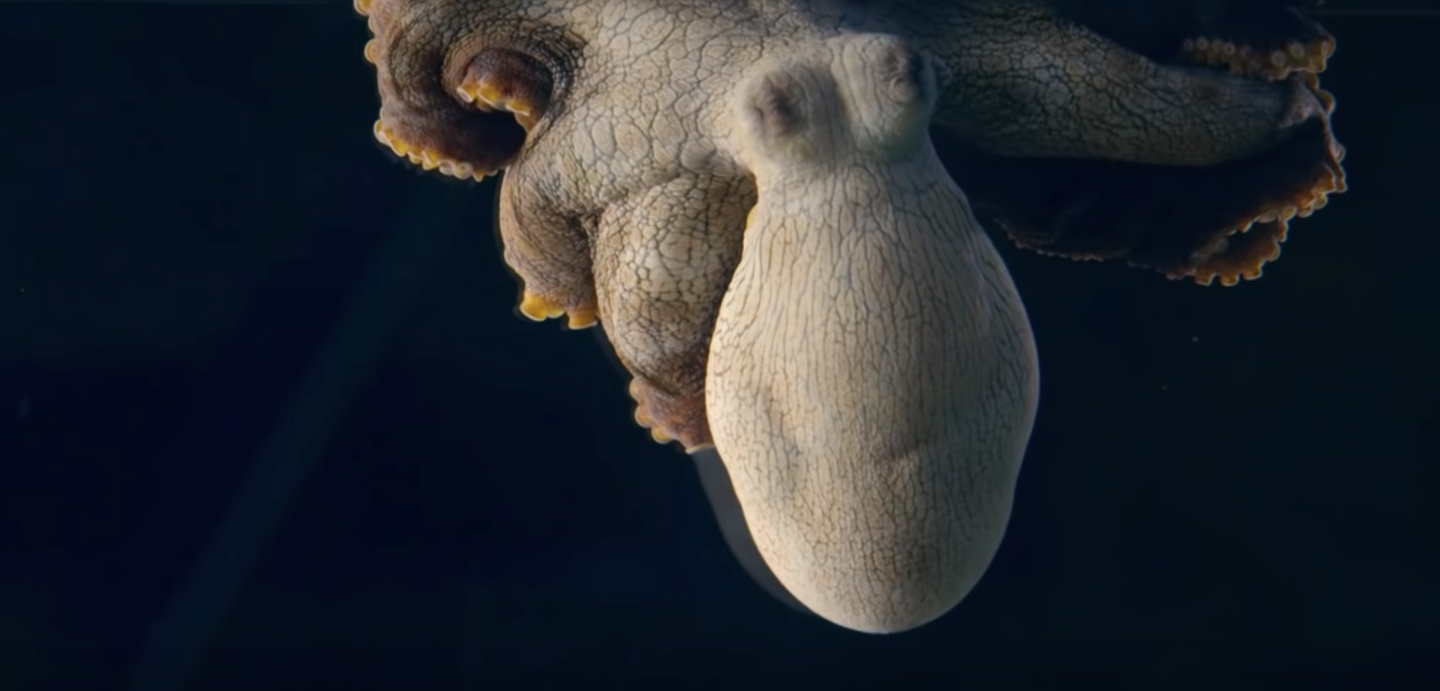This sleeping octopus twitches in technicolor—but is she dreaming?
Either way, we're dazzled by Heidi's display.

In the house of David Scheel, Heidi the octopus lies dreaming—potentially.
A video has been making rounds on the internet showing Heidi asleep in her tank. Her mantle (the ball of muscle behind her eyes) expands and deflates, and you can practically hear her tiny cartoon snores.
Each time the octopus twitches, her body pulses with a new array of colors and textures and patterns. Her skin shifts from a dappled yellow to a pale white, then a dark, rippling magenta, before settling on a yellow and black paisley. She’s clinging to the bare wall of her tank, yet her colors change as if she’s swimming across the ocean floor, trying to blend in with the sun-dappled sand or the murky ocean.
“If she is dreaming, it’s this dramatic moment,” narrates David Scheel, a marine biologist from Alaska Pacific University. Part of a soon-to-be-aired PBS documentary, the video captures Scheel’s stunned, real-time reaction to Heidi’s rainbow display. He guesses that Heidi could be dreaming about chasing a crab, the same way we imagine dogs dream of chasing cats.
“If she’s dreaming, that’s the dream,” Scheel concludes. The prospect is exciting, but also very open-ended—there’s hardly any scholarly work available to support this claim. In general, “dreaming” is a tricky concept to nail down, especially for something as alien as a marine invertebrate. Heidi’s performance in the video, enchanting as it is, raises more questions than answers. We did our best to address some of those questions here:
How do octopuses change color?
All cephalopods have sacs of pigment in their skin called chromatophores. These little organs are elastic—they can expand or contract to each make a pixel of color, says Stanford biologist William Gilly. While awake, octopuses change color to camouflage with their environments, and sometimes to communicate with each other. They can also change colors intentionally, to reflect the environment they’re moving toward.
When an octopus changes color, there are actually hundreds of thousands of chromatophores flickering underneath the skin. The chromatophores shift under the control of the brain—mostly. “The brain certainly has an important role,” says Gilly. There’s also a pathway under the skin itself, which allows the chromatophores to communicate with each other, free of conscious control.
What’s the point of changing color while asleep?
It might seem disadvantageous for an animal to draw attention to its vulnerable, sleeping self with a colorful display. Keep in mind, however, that Heidi is an octopus in a tank. Wild octopuses rarely sleep out in the open. Typically, they will settle into a den or a favorite spot, hidden away. That’s part of the reason why this footage of Heidi is so rare and interesting.
Additionally, posits Gilly, if your outline or colors are continuously changing, then it might keep you from sticking out as a static object on the seafloor.
How do we know that octopuses sleep?
Octopuses are confirmed weirdos, with three hearts, blue blood, and more than 500 million neurons (humans have only 100 million). Those brain cells aren’t centralized to their heads, either—more than half live in their arms. But even with all of that brainpower (and plenty of evidence of high intelligence), the mollusks are so morphologically different from mammals that, for a long time, scientists weren’t even sure if octopuses slept at all, let alone dreamed.
For an organism to be considered “asleep,” it should fulfill several key criteria: it must go very still, become less responsive than it is while awake, and—should it miss a night of sleep—strive to compensate by sleeping more later on.
Octopuses have been shown to display most of these behaviors. “They become quiescent and less responsive to disturbance, but can be roused. After a period of sleep deprivation, they sleep longer to catch up,” Scheel tells PopSci. “And their brains are active during these sleep behaviors.” That suggests they might have the capacity to dream.
How can scientists determine if the octopus is dreaming?
Dreams usually occur during REM sleep (the phase of sleep characterized by Rapid Eye Movement). Studies have found that octopuses do sleep, and that their cephalopod cousins, cuttlefish, exhibit something like REM sleep.
At the moment, says Scheel, “the science of invertebrate sleep is still exploring these behaviors, and whether we should conclude octopuses dream.” Because dreaming is such a human concept—it’s a manifestation of the subconscious, and not exactly something we can ask an animal about—we may never really know for sure.
Scheel doesn’t claim to be a sleep biologist, nor is he an expert in sleep behaviors, but something about Heidi’s performance makes him believe that octopuses are just as capable of dreaming as humans are. These highly intelligent animals are highly distinct from us, he says, but it’s important to remember that our experiences might not be so different.
What are the other possible explanations for this behavior, if not “dreaming?”
“There may be no dream, only minor muscle contractions, like twitching,” says Scheel. This color change pattern might be the equivalent of the octopuses’ chromatophore muscles jerking and relaxing as they sleep. Less poetic, for sure.
Gilly is pretty skeptical that the changing colors are indicative of dreaming. “Color change is just a neuromuscular behavior, just like moving our arms or fingers or anything else,” says Gilly. “It’s not necessarily a conscious thing.” If only our own leg twitches and snores were this lovely to look at.
Do other animals dream?
It’s difficult to definitively “prove” dreaming in any species, although scientists have collected evidence indicating that rats and cats “see images” and “map out future movements” during their REM sleep cycles. Dogs and birds also enter REM sleep, during which they display heightened brain activity.
“Even for humans,” says Scheel, “the function of dreams is still under investigation.”
The sequence was taken from the upcoming PBS NATURE’s Octopus: Making Contact. The full documentary will air on October 2.